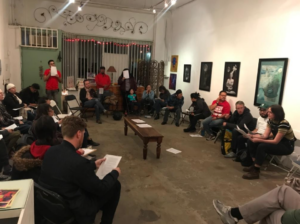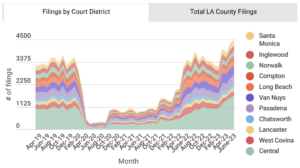Meet Maintainers Fellow Terra Graziani: Maintaining Home, Abolishing Evictions
My name is Terra Graziani. I am a researcher and organizer, and for the past ten years I have worked in the tenant movement in California in various roles, building tenant power through public education, community-based research, and organizing. I am a PhD student in Geography at CUNY Graduate Center studying housing, land, and abolition. I also help run a volunteer collective called The Anti-Eviction Mapping Project, a data-visualization, critical cartography, and multimedia storytelling collective documenting dispossession and resistance in gentrifying landscapes. Working with a number of community partners and in solidarity with housing movements globally, we produce digital maps, software and tools, narrative multimedia work, reports, and community events. Our narrative oral history and video work centers the displacement of people and complex social worlds, but also modes of resistance. Maintaining antiracist and feminist analyses as well as decolonial methodology, the project creates tools and disseminates data contributing to collective resistance and movement building.

My first job in the tenant movement, back in 2014, was at The Eviction Defense Collaborative (EDC) in San Francisco, where I was Community Outreach Coordinator. I learned about so many things in this role, one of which was the landscape of tenant legal aid in California. EDC is sort of a “first responder” clinic for evictions in San Francisco – if you get eviction papers, you go – even the city tells you to go — there first. We had a team of over twenty eviction defense lawyers, and for the most part, like all the legal aid organizations helping tenants in the city, they spent most of their time doing eviction defense. Though slumlords and abuses against tenants are plentiful, affirmative cases, or cases brought by the tenant against their landlord, are extremely rare. This is because the attorneys that tenants have access to, for the most part, don’t have time to take on these cases (1). My coworkers and I talked about this imbalance often and at the time attempted to address it by designing an intake form that would free up more time for attorneys to take on more full-scope cases.
Fast forward to the start of the pandemic, AEMP teamed up with The Debt Collective, The Los Angeles Tenants Union, and UCLA’s Institute on Inequality and Democracy to develop a toolkit to help tenants respond to the worsening housing crisis, called The Tenant Power Toolkit. When a tenant gets eviction papers in California, they have just five days to file what’s called an Answer in court – a crucial step which if taken buys the tenant more time, but if not results in a default judgement and an eviction on their record. Our tool helps tenants file this response with the court electronically, without having to find an attorney. More than four thousand tenants have already successfully used the tool, and once tenants use the tool, we work to plug them into their local tenant organizing community. Though this tool is on its face a legal aid tool, we designed it always as an entry point to organizing. It is often said in the tenant movement, “the best way to prevent homelessness is to keep people in their homes,” which in terms of this tool means helping tenants in court to keep them in place and buy them more time to organize and take care of their communities. Additionally, because the tool collects unique tenant-reported eviction data across California, we can track which tenants may share the same landlord and help them organize across a landlord’s portfolio to resist their evictions.

Though the housing crisis existed prior, the COVID-19 pandemic worsened conditions for tenants, most visibly through the expansion of rental debt. As eviction moratoriums expire in cities across the US, rental debt threatens the stability of communities where tenants struggle to stay put. This is the landscape in which I ground my Maintainers Fellowship. Focusing on Los Angeles, CA, I am asking: how does rent debt change the terrain tenants must navigate to maintain their communities? How can we as tenants fight back? This research is done in partnership with members of The Los Angeles Tenants Union, learning together as we go. My hope is that this work helps tenants build power in new ways that is responsive to the current moment.

As we remind ourselves of the importance of maintaining home, it is just as important to consider the systems, structures, and conditions of possibility that we want not to maintain, or rather, to abolish — eviction, rent, private property, to name a few. I have been part of The Maintainers community since about 2017, when a professor at UCLA referenced them in class, and have appreciated the call to question the drive for innovation and give more flowers to maintenance work. In the case of tool-building, this can get tricky. While we have no interest in replacing eviction defense lawyers – and in practice, have not – in addition to helping tenants build power via organizing, the TPT could intervene in the nonprofit landscape which helps tenants only on their back foot and not on their front. In this way, I see the TPT as a new tool that will help maintain communities and find new ways to resist very old structures we want not to maintain.
(1) For more on why, read The Revolution Will Not be Funded